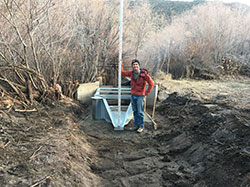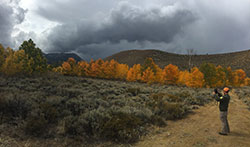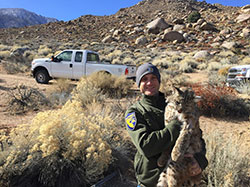
Installing a water measurement flume at East Walker River Wildlife Area (Mono County)

Site visit to Green Creek Wildlife Area (Mono County)

Working a bobcat capture to deploy GPS tracking collar
Aaron Johnson is an environmental scientist in CDFW’s Bishop office, in Inyo County. A Bay Area native, Aaron spent much of his childhood doing two things – exploring the East Bay hills above his hometown of Albany, and tagging along with his dad, who was a photographer for the Nature Conservancy.
Aaron earned an environmental studies degree at UC Santa Cruz, then worked for a local land trust, the US Department of Agriculture and California State Parks before settling in with CDFW in 2015. Today his work involves land management and invasive plant management on the 22,000 acres of CDFW wildlife areas and ecological reserves in Inyo and Mono counties.
Can you share an early memory of being outdoors with your dad? What kind of wildlife or plants do you remember seeing?
One highlight was visiting Carrizo Plain (San Luis Obispo County) in the early ’90s with my parents. I recall catching western fence lizards and admiring their colors, and climbing all around on rusty farm equipment in the tall grass. It’s also where my dad first let me drive on backroads a few years later. I now have a lot more sympathy for the poor clutch in that 4-Runner. I look forward to taking my daughter out there for the first time.
What’s your role as a land manager in Bishop?
A number of our properties are managed as habitat for mule deer herds. We also manage for public recreation opportunities, including hunting and birdwatching. One day I can be working in the High Sierra near Monitor Pass in Mono County, and the next I can be working down in the Mojave Desert, doing something entirely different.
Right now the big project is getting all our irrigation systems flowing. That’s typical in the spring. We maintain irrigation infrastructures, which involves repairing ditches and head gates, and getting our water measurement devices all set up so we can keep track of our water rights correctly. The latter is a neat mix of some construction work, engineering, math – a little bit of everything – in order to meet new requirements we have as a state agency. It’s important to catch that spring runoff from the snow melt so we can green up our properties for deer, grow cover for upland game birds and maintain ponds for ducks and other waterfowl.
What kind of invasive plants do you eradicate, and why?
One of our big springtime tasks is treating invasive plants. Perennial pepperweed is the one we’re always chasing. Then we’ve got Canada thistle, and poison hemlock, which is taking over a couple of livestock pastures. These plants are concerning because they have the capacity to displace native plant species that have a limited range, or special status. There are plenty of plants that aren’t native – the ones we’re focused on have the capability of being a monoculture and displacing either other plants or being harmful to wildlife.
Can you describe the process for removing these plants?
In some cases removal includes pulling the plants out by hand, but most often it involves carefully targeted herbicide applications, either with a backpack or ATV-mounted sprayer. We’ve been out a couple of times just recently to a property where we have two really special rare plants, the Owens Valley checkerbloom and Parish’s popcornflower. They grow in alkali meadows at the edge of Owens Dry Lake. Unfortunately, a few years ago, pepperweed showed up for the first time after a visit by some free-ranging cattle, and we found out that it does really well in the same microtopography as the popcornflower. Given the sensitivity of those species, we’ve had to work to develop a treatment strategy that is less reliant on chemicals. We’ve also erected a temporary electric fence to minimize livestock disturbance since the habitat is more resistant to further invasion without the added disturbance. We’ve been manually removing the pepperweed to keep it from getting more established. As with most things in land management, we will evaluate how these management strategies go this year and will adapt our approach as needed.
To some, your job description might sound like endless yardwork. What do you like about the work you do?
The eastern Sierra is one of the last wild portions of the state. There is a huge amount of undeveloped public land, with relatively intact migration routes for wildlife and functioning and intact ecosystems. In a way, we are charged with saving the best of what’s left of California.
It’s always interesting – a really nice balance of field work and trying to put together resources for the public. It’s mending fences to keep livestock either on or off of the wildlife area, and doing wildlife surveys and rare plant surveys, and writing land management programs for public review, and issuing use permits to researchers and learning about all the neat things they’re doing.
What’s the most challenging part of your job?
I think the most challenging part of the job is setting priorities and staying focused on the most important objectives. It’s the nature of land management that every day presents some type of new interesting challenge. This can sometimes be an enjoyable aspect of the work but can also distract from getting other important tasks done, like long-term planning. Whether the task is an emergency repair to a fence to keep livestock out of a rare plant population, treating an invasive plant at the most opportune time, or finishing an environmental document – it all needs to get done.
If you had unlimited time and resources, what project would you like to implement on your lands?
I think we do a really good job with our small team given the broad geographic range of the properties we manage. Thinking of the “use and enjoyment by the public” aspect of CDFW’s mission, I would really like to see more interpretative, educational and recreational opportunities developed for the public. In places where public access is consistent with our management objectives, this could mean educational kiosks, maps and habitat improvement projects to improve hunting and nature viewing opportunities, such as managed wetlands for waterfowl or seeding/planting forage species for deer at a degraded site. We have a number of such projects that could be completed with California Environmental Quality Act (CEQA) funding. For more remote or sensitive sites, additional web content, species profiles or virtual tours are probably more appropriate. I’ve been really impressed by how other agencies have been managing this kind of outreach during the current crisis. I’d also like to see our unique properties used for academic purposes – school groups or research.
What advice would you give to someone who is interested in working in wildlife or lands management? What’s the best path to take to end up with a job like yours?
My advice would be to seek out opportunities to gain experience in related fields. After a season working on a backcountry trail crew for the Forest Service after high school, I got interested in meadow restoration. That helped direct me into a restoration ecology course at UC Santa Cruz that resulted in an internship with State Parks. When they handed me a drip torch and let me set fire to Coastal Prairie, it became my senior project in disturbance ecology, and led me to develop respect for bunchgrasses. After a few years doing invasive plant work, and a few more in land conservation, I ended up here. It’s been a really nice blend of a number of my interests.
###
CDFW Photos